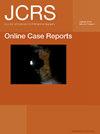Fuchs endothelial corneal dystrophy masking an underlying postrefractive surgery ectasia
Q4 Medicine
引用次数: 0
Abstract
Introduction: This article describes a case presenting Fuchs endothelial corneal dystrophy (FECD) masking an underlying postrefractive surgery ectasia. Patient and Clinical Findings: A 69-year-old woman presented in January 2022 with blurriness, halos, and glare in the left eye. Ocular history included a photorefractive keratectomy performed twice in her left eye in 2007 for hyperopic astigmatism. A diagnosis of asymptomatic Fuchs dystrophy was noted in 2010. She had acute decompensation of the cornea in the left eye because of FECD, and the first Descemet-stripping automated endothelial keratoplasty (DSAEK) with cataract surgery was performed in 2018. Diagnosis, Intervention, and Clinical Findings: The patient had a failed DSAEK graft in the left eye. A repeat DSAEK was performed in 2022, and 6 months postoperatively, the patient started showing signs of ectasia in the left eye. The authors believe the ectasia was preexisting but masked by the failed DSAEK graft and FECD and started showing after corneal deturgescence postoperatively. Conclusions: The presence of FECD and corneal ectasia can complicate diagnosis because of overlapping clinical and topographic features. This case highlights the importance of preoperative topography with epithelial/stromal thickness mapping in patients with a history of multiple refractive corneal procedures to consider the possibility of ectasia and prevent unforeseen outcomes and complications. Further research is necessary to determine standardized imaging techniques, particularly in cases of concurrent diseases.富克斯角膜内皮营养不良掩盖了潜在的术后扩张
简介:这篇文章描述了一个富氏角膜内皮营养不良(FECD)掩盖了潜在的白内障手术后扩张的病例。患者和临床表现:一名69岁女性,于2022年1月出现左眼模糊、光晕和眩光。眼部病史包括2007年因远视散光在左眼做了两次光屈光性角膜切除术。2010年被诊断为无症状的富克斯营养不良症。由于FECD,她患有左眼角膜急性失代偿,并于2018年进行了第一次descemet剥离自动内皮角膜移植术(DSAEK)和白内障手术。诊断、干预和临床表现:患者左眼移植DSAEK失败。2022年再次进行DSAEK手术,术后6个月,患者开始出现左眼扩张的迹象。作者认为,扩张是预先存在的,但被失败的DSAEK移植和FECD掩盖,并在术后角膜消肿后开始出现。结论:由于FECD和角膜扩张的临床和地形特征重叠,使诊断复杂化。本病例强调了术前对有多次屈光性角膜手术史的患者进行上皮/间质厚度测量的重要性,以考虑角膜扩张的可能性,防止不可预见的后果和并发症。需要进一步的研究来确定标准化的成像技术,特别是在并发疾病的情况下。
本文章由计算机程序翻译,如有差异,请以英文原文为准。
求助全文
约1分钟内获得全文
求助全文

 求助内容:
求助内容: 应助结果提醒方式:
应助结果提醒方式:


